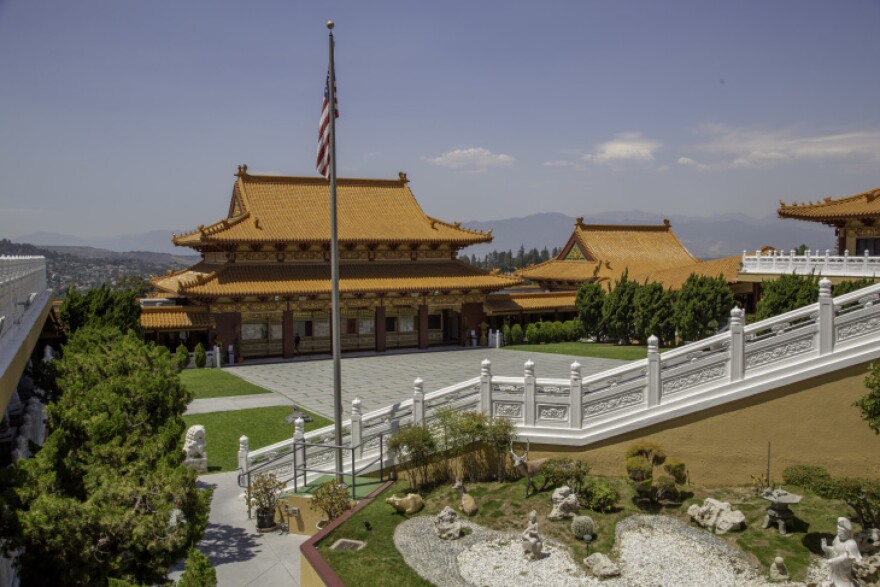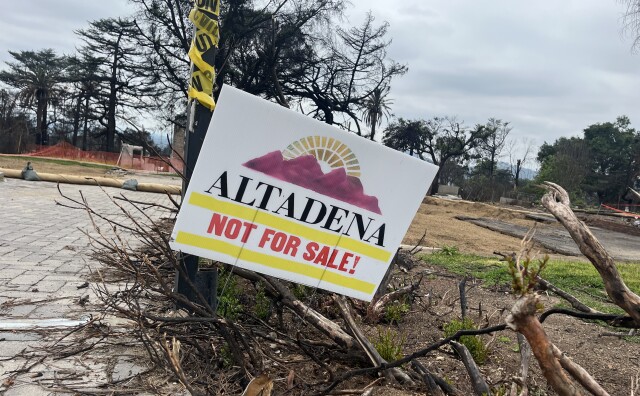Congress has cut federal funding for public media — a $3.4 million loss for LAist. We count on readers like you to protect our nonprofit newsroom. Become a monthly member and sustain local journalism.
The Modern Mountain Monastery In Hacienda Heights Where Anyone Can Have An $8 Veggie Lunch

High in the hills of the San Gabriel Valley, devotees and casual wanderers climb toward the ochre-topped, pagoda-style roofs of the Hsi Lai Temple, plunked amid the suburban sprawl of Hacienda Heights. The sprawling, 15-acre compound is the very model of a modern mountain monastery. Inside, intention isn't just a matter of bowing in respect before the Buddha; it's in every bite. The temple, one of the largest Buddhist worship sites in the Western Hemisphere, serves an $8 vegetarian lunch to anyone who comes through its doors.
The Hsi Lai Temple's name means "coming West." A sign for the International Buddhist Progress Society, the name for the Buddhist order in its Chinese Mahayana tradition, marks the entrance. The order was founded by Master Hsing Yin in the 1960s and this temple opened in 1988 — after several years of battling with the Hacienda Heights community.
"We're very inclusive," says Venerable Miao Hsi, a nun who has lived at the monastery for three decades. Her head is shaved and she wears the order's traditional clay-brown robe. "We just want to share our teachings and our culture." Part of that culture is vegetarianism.

On your way to the dining room, you'll pass through the ornate Bodhisattva Hall, dedicated to five enlightened sages or "Buddhas-in-training," and walk past a garden with statues of bald, golden-robed figures sitting in lush greenery. The statues represent values like discipline, restraint and mindfulness. Consider this a cue to take a meditative approach to your repast. After all, the dining hall is named after the Hall of Five Contemplations. Among the statues you're supposed to reflect on: "the work that went into the food" and whether or not you "merit this offering."
Inside the spartan dining hall you'll find a cafeteria-like setting with a Buddha figure in the center. Although the food is served buffet-style, this isn't Las Vegas. Signs in several languages remind diners to only eat what they can finish. Under fluorescent lights, volunteers, chatty school children and the occasional monk commune over bright, stewed zucchini and bell peppers and oily bok choy. There's also rice or noodles (maybe spiked with chile sauce), slow-cooked tofu and quarter-sized bamboo shoots. The lightly fried vegetables — on a recent day they included the double carb whammy of tempura potatoes — are a treat. A simple porridge or a veggie broth with dumplings rounds out the offerings.

The Hsi Lai Temple's dining selections change daily depending on what's in season and what local donations they receive, a typical practice at most temples. It may also explain why stale Doritos sat next to fresh watermelon at the Western-style salad bar. The vegetarian food is distinctive for its lack of spices like onions, garlic, ginger and chive. They're forbidden in meals because they're thought to stir up lust and bad tempers. Plus, they create body odor.
The food is still flavorful and filling. "We say food is medicine. Food isn't something of greed," explains Hsi. She adds that the monks often take part in a meditative meal, chanting prayers before and after they dine, and eating in silence.

After lunch, you can stroll the the temple's peaceful grounds. The main shrine is flanked by an astonishing 10,000 small golden Buddhas statues, meant to remind worshippers of those who have attained enlightenment. A lion guards each corner of the courtyard and, according to Buddhist teachings, the creature's great roars awaken us from our ignorance. There's also an array of gongs and drums, which the monks clank during services.
The grand surroundings are built to mimic ancient Chinese monasteries with a nod to the architecture styles of the Ming and Qing dynasties. It wasn't always so tranquil, Hsi says. When the temple was first built in the 1980s, its founders faced fierce resistance from some members of the Hacienda Heights community.

Neighbors didn't want the Buddhists to build there because they were concerned the Chinese architecture wouldn't fit in with the surroundings. They were worried about traffic, parking and... other issues. "Some residents asked about animal sacrifices — Buddhists don't do them — and noise from pre-dawn gongs and chanting," according to a 1993 Los Angeles Times story. "Others feared a religious cult that would try to entrap their children."
After an intense and emotional fight, construction on the temple finally began in 1985. Decades later, the Hsi Lai Temple is mostly welcomed by its neighbors although the initial resistance remains sharp in Hsi's memory.
"There are still some die-hards in the community who consider us an intruder but most people recognize us for what we have done for the community," she says. "When we first went to the 4th of July parade, we were booed. You wouldn't believe it. Eventually they have come to accept us and, in the last 10 years, we keep winning the parade's big prize."

The Hsi Lai Temple has also worked to become a part of the community by holding services in both English and Chinese, funding scholarships to local schools and serving as a community hub. Girl Scout troops regularly meet there and it hosts an inclusive Chinese New Year festival, karaoke parties and meditation workshops.The vegetarian meals are part of the temple's welcoming spirit.
August Peterson, a Hsi Lai Temple tour guide who can switch between Mandarin and English without a breath, says the dining hall is rooted in founder Hsing Yun's childhood. The monk grew up during the Chinese Civil War, without enough food. Because of that, he wanted anyone who came through his temple to be able to fill their bellies. All who attend the Sunday services are invited to dine at the temple without having to pay for it.

"He didn't want anyone coming to the temple hungry to leave hungry," says Peterson. "He was big on making sure people had full stomachs."
If you visit the temple with a curious mind and an empty stomach, you might also leave with a full spirit.
Los Angeles is a city of seekers, a magnet for those who want the perfect body, the perfect soul. This story is part of Seeker Lunch, our series about the diverse and offbeat faiths in our city — and the food on their tables. Consider it a snack for the spiritually curious.
Hsi Lai Temple
3456 Glenmark Dr., Hacienda Heights. 626-961-9697.
Open Tuesday - Sunday, 9 a.m. - 5 p.m.
As Editor-in-Chief of our newsroom, I’m extremely proud of the work our top-notch journalists are doing here at LAist. We’re doing more hard-hitting watchdog journalism than ever before — powerful reporting on the economy, elections, climate and the homelessness crisis that is making a difference in your lives. At the same time, it’s never been more difficult to maintain a paywall-free, independent news source that informs, inspires, and engages everyone.
Simply put, we cannot do this essential work without your help. Federal funding for public media has been clawed back by Congress and that means LAist has lost $3.4 million in federal funding over the next two years. So we’re asking for your help. LAist has been there for you and we’re asking you to be here for us.
We rely on donations from readers like you to stay independent, which keeps our nonprofit newsroom strong and accountable to you.
No matter where you stand on the political spectrum, press freedom is at the core of keeping our nation free and fair. And as the landscape of free press changes, LAist will remain a voice you know and trust, but the amount of reader support we receive will help determine how strong of a newsroom we are going forward to cover the important news from our community.
Please take action today to support your trusted source for local news with a donation that makes sense for your budget.
Thank you for your generous support and believing in independent news.

-
People moving to Los Angeles are regularly baffled by the region’s refrigerator-less apartments. They’ll soon be a thing of the past.
-
Experts say students shouldn't readily forgo federal aid. But a California-only program may be a good alternative in some cases.
-
The program is for customers in communities that may not be able to afford turf removal or water-saving upgrades.
-
More than half of sales through September have been to corporate developers. Grassroots community efforts continue to work to combat the trend.
-
The bill would increase penalties for metal recyclers who possess or purchase metal used in public infrastructure.
-
The new ordinance applies to certain grocers operating in the city and has led to some self-checkout lanes to shutter.







